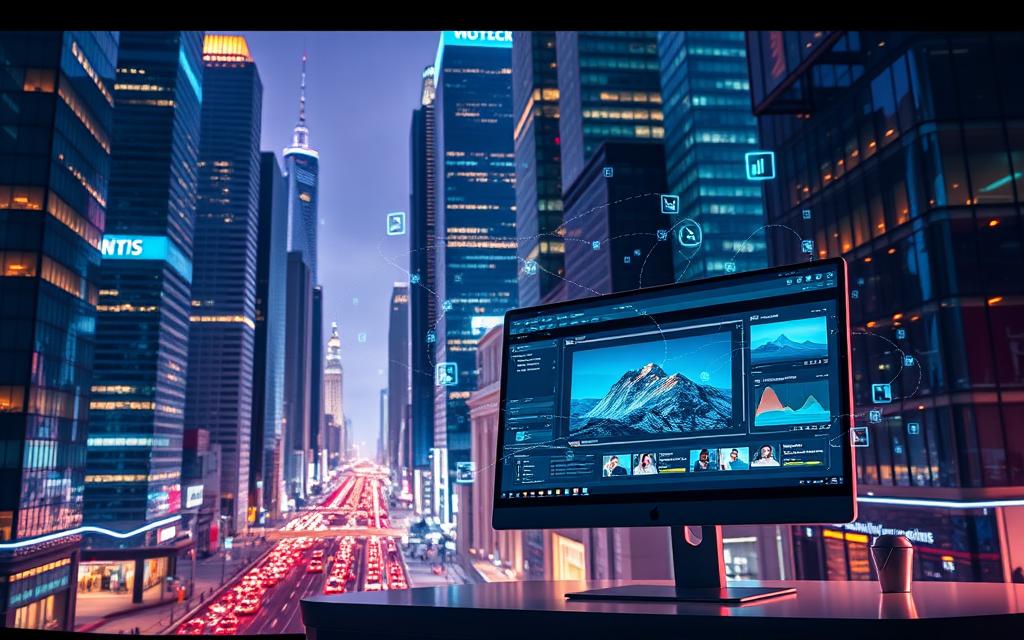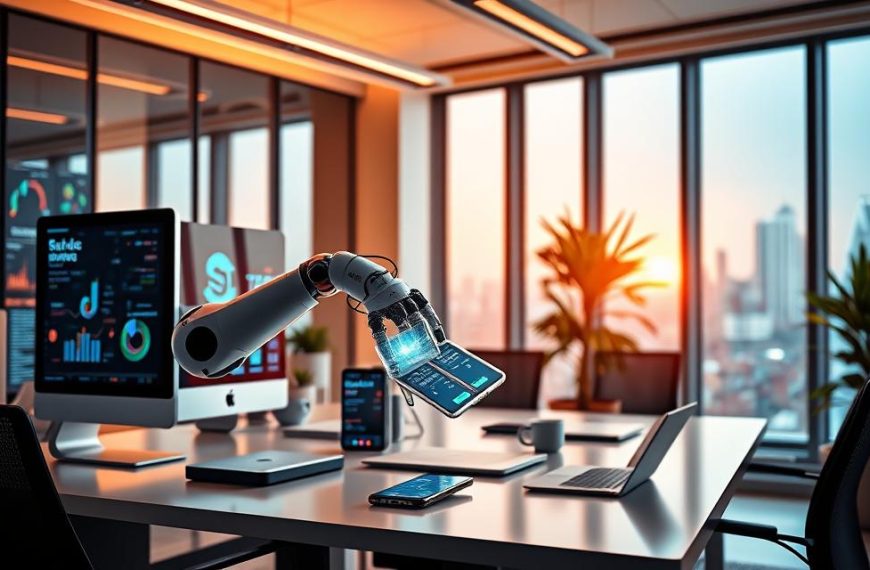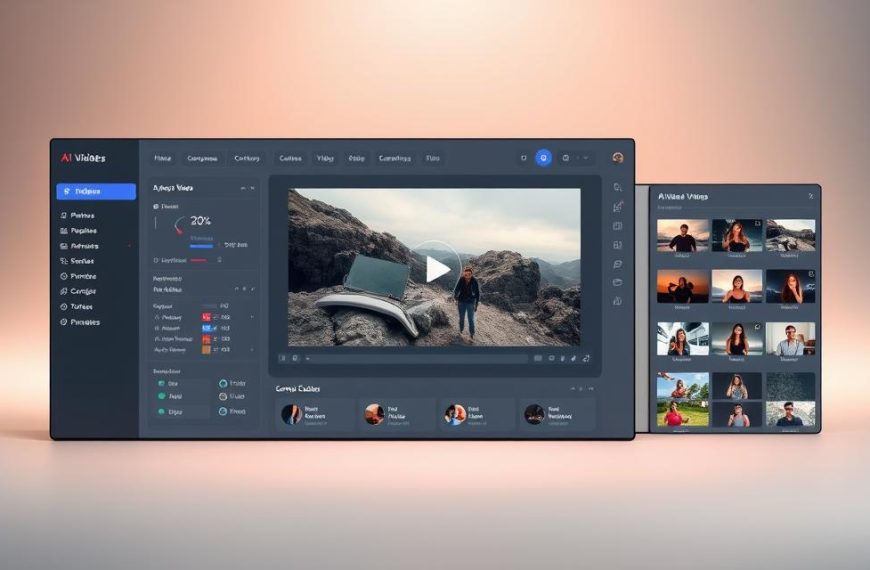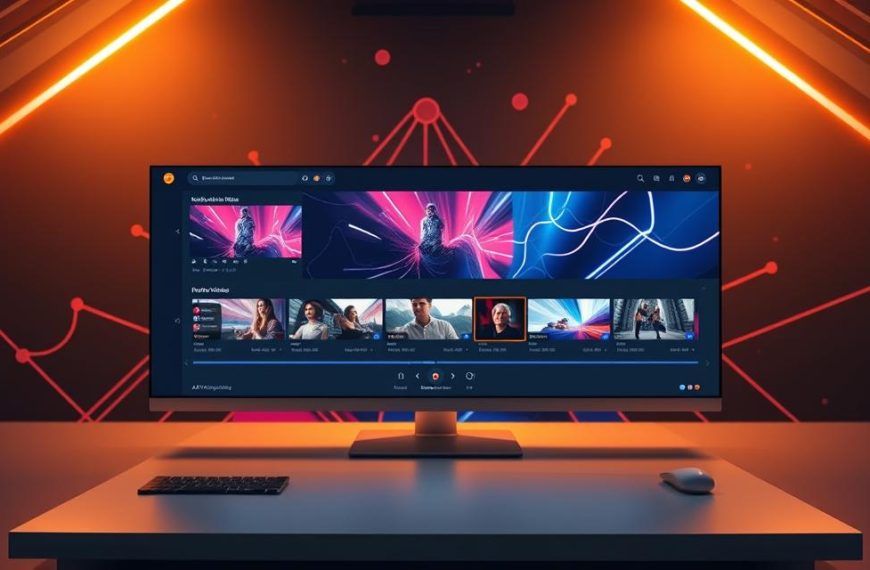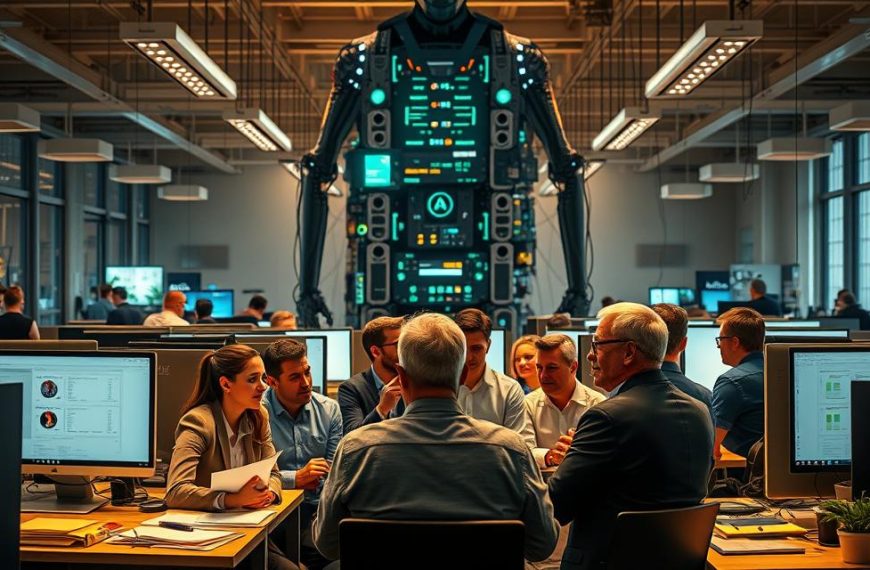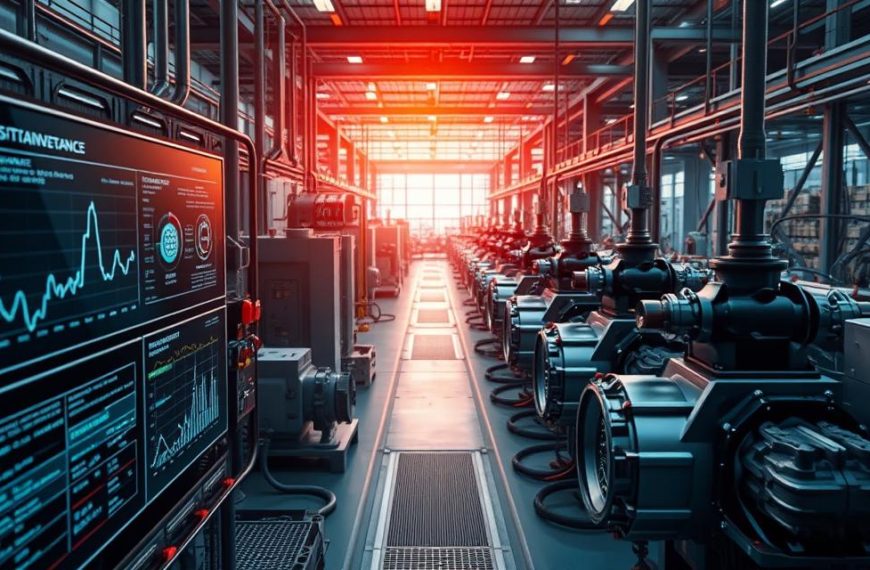Artificial intelligence is changing how we make digital content. It’s making a big impact on video production. Now, AI video creation tools let anyone make professional-quality videos.
YouTube is leading the way with new features. They use Google’s Veo 2 to turn static images into moving videos. This is a big change in short-form content AI making.
AI does more than just create content. It also makes it personal and tracks how well it does. This makes watching videos more interesting and relevant to each viewer. The whole world of artificial intelligence video is getting smarter and more custom.
This new tech helps creators and makes watching videos better. It’s easier than ever to make engaging videos. We’re seeing a big change in how we tell stories and share content online.
The Evolution of Short-Form Video and AI Integration
The journey of short-form video platforms is truly fascinating. It shows how artificial intelligence has changed content creation, distribution, and consumption. This change has happened across major platforms.
From Vine to TikTok: The Short-Form Revolution
Vine started the six-second video trend in 2013. It introduced ultra-short, looping content. Even though Vine closed, it set the stage for today’s short-form videos.
TikTok became the leader, changing how we watch videos. Its AI content discovery AI system knows what users like. It makes feeds that keep people watching for a long time.
YouTube Shorts’ Initial AI Features
YouTube Shorts came out to compete in the short-form video world. It used advanced AI from the start. One cool feature was the image-to-video tool powered by Google’s Veo 2 model.
This tool turns static images into moving six-second clips. It shows how AI can make creating content easier without losing quality.
YouTube Shorts also has other AI effects:
- Automated background removal and replacement
- Smart cropping for optimal mobile viewing
- Real-time filters that adapt to content context
Instagram Reels’ Early Algorithmic Approach
Instagram Reels started with a focus on finding new content for users. Meta’s AI helped match content with what users like. This was different from just showing videos in order.
Instagram Reels’ early social media algorithms helped creators find new audiences. This was a big change from just showing videos in order. It used AI to guess what content users would like.
Instagram Reels’ first AI features included:
- Content classification based on visual and audio analysis
- Engagement prediction models to surface potentially viral content
- Cross-platform content suggestions from Facebook’s data network
| Platform | Primary AI Focus | Key Initial Features | Content Discovery Approach |
|---|---|---|---|
| YouTube Shorts | Creation Enhancement | Image-to-video conversion, AI effects | Integration with YouTube’s existing recommendation system |
| Instagram Reels | Content Distribution | Behaviour-based matching, cross-platform data | Standalone discovery feed with personalised suggestions |
| TikTok | Personalised Engagement | Precise interest mapping, viral prediction | Highly addictive, endlessly scrolling For You page |
The table shows how each platform used AI differently at first. YouTube used its own system, Instagram used Meta’s data, and TikTok focused on algorithms from the start.
This video platform evolution shows AI’s key role in short-form videos. The technology keeps improving, leading to new ways of creating and sharing content on all major platforms.
Content Creation Revolution Through Shorts AI
Artificial intelligence is changing how we make short videos. It removes the need for complicated editing tools. Now, creators can focus on being creative.
Automated Editing and Enhancement Capabilities
AI tools now make videos look better automatically. They adjust lighting and composition for a polished look. This means no need for manual editing.
AI-Powered Background Removal and Effects
AI can now separate subjects from backgrounds easily. YouTube Shorts use cool effects like doodle animations. Selfie transformations can make scenes look like underwater adventures.
Guides show how to use AI backgrounds and clips easily. It recognises people and movements for effects. No green screens needed.
AI looks at colours and lighting to suggest the best look. It considers mood and style for filters. This keeps content looking good every time.
AI learns from successful videos to suggest colours. It adapts to trends and what people like. This makes content that grabs attention.
Smart Content Generation and Template Systems
AI templates adapt to what you need. These smart templates AI systems suggest layouts and transitions. They save time without losing quality.
AI-Driven Music and Audio Synchronisation
AI matches music to video cuts automatically. It understands rhythm for perfect timing. This makes videos sound professional without manual effort.
AI picks music that fits the mood and what people like. It adjusts tempo for the right feel. This makes audio and video work together well.
Automated Captioning and Text Overlay Features
AI creates accurate captions in British English. It gets the grammar and phrasing right. This helps everyone understand the content better.
AI suggests where to put text for overlays. It recommends fonts and sizes for a professional look. This makes text enhance the video, not distract from it.
These automated content creation features are the future of short videos. AI in AI video editing helps all creators. It keeps getting better, making top-quality content easy for everyone.
Personalisation and Discovery: AI’s Role in User Experience
Short-form video platforms are special because they find the right viewers for each video. Artificial intelligence is the secret behind this, learning from how users interact to show them what they want to see.
Advanced Recommendation Algorithms
Today’s platforms use content discovery AI to understand what users like. These systems look at lots of data to get to know what each person prefers. They go beyond just how much users watch to understand their habits and what they’re interested in.
TikTok’s For You Page Algorithm Mechanics
TikTok’s algorithm is known for making its feed very personal. It looks at how users interact with videos, the video itself, and even device settings. This helps TikTok show users content that’s just right for them.
It considers things like:
- Video likes, shares, and how much users watch
- What kind of videos users like and the sounds they prefer
- Where users are and what language they speak
- How users interact with creators
This detailed approach lets TikTok show both new and well-known creators. It keeps the feed fresh and interesting for users.
YouTube Shorts’ Content Matching Systems
YouTube Shorts uses Google’s big data to match videos with what users like. It looks at what users watch and search for on YouTube to find the right Shorts for them.
YouTube’s system focuses on:
- What users like across different platforms
- How well videos match what users are searching for
- What users watch on YouTube, whether it’s long or short videos
- What’s popular in the community and new topics
This way, YouTube Shorts fits well with the rest of YouTube. It makes watching videos a smooth and enjoyable experience.
Adaptive Streaming and Performance Optimisation
AI also helps make sure videos play well, no matter the internet speed. Adaptive streaming technology changes video quality to match the internet speed. This keeps videos playing smoothly.
Bandwidth-Aware Quality Adjustment
Platforms use smart systems to check the internet speed in real-time. They look at how fast the internet is, how long it takes to send data, and how stable it is. This helps them choose the best video quality for each user.
This technology chooses to keep videos playing smoothly over having the highest quality. It makes sure users can watch without annoying pauses. This makes users happier and more likely to keep watching.
Real-Time Content Delivery Optimisation
AI helps get videos to users by finding the best route. It considers where the user is and the internet speed. This makes sure videos get to users quickly and efficiently.
It does this by:
- Choosing the best server based on how busy it is
- Storing popular content so it’s ready to go
- Using smart ways to make videos smaller
- Adjusting for whether users are on Wi-Fi or mobile data
This advanced adaptive streaming technology makes sure videos play well, no matter the internet. It helps short-form videos reach more people, even those with slower internet.
Analytics and Strategic Insights Powered by AI
Artificial intelligence has changed how creators measure success and plan their content. It uses video analytics AI systems to give deep insights into viewer behaviour and content performance.
Performance Measurement and Engagement Tracking
Modern AI tools track more than just view counts. They analyse performance metrics together, giving creators useful data.
Real-Time Viewer Behaviour Analysis
AI systems watch viewer interactions live. They find out when viewers are most engaged or lose interest.
The tech looks at:
- Average watch time per segment
- Re-watch patterns for specific content portions
- Interaction rates with interactive elements
- Audience retention curves throughout the video
Audience Demographics and Preference Mapping
Advanced AI creates detailed audience profiles. It uses viewing patterns and engagement metrics to find out who the audience is and what they like.
YouTube uses this data responsibly, as stated in their AI policy: “User feedback and engagement patterns help us improve our recommendation systems while maintaining strict privacy standards.”
Predictive Analytics for Content Strategy
Modern AI tools are great at predicting trends and improving content strategies. This predictive content strategy changes how creators plan their content.
Trend Prediction and Content Opportunity Identification
AI systems look at big datasets to spot trends early. They check:
- Search query patterns across platforms
- Content performance in niche categories
- Cross-platform engagement metrics
- Seasonal content performance history
Optimal Posting Time and Frequency Recommendations
Intelligent systems suggest the best times to post. They look at:
- Time zone distributions of your audience
- Historical engagement patterns by day and hour
- Content type performance variations by timing
- Platform-specific algorithm preferences
These tips help creators get more views and engagement. The AI gets better over time, making its suggestions even more accurate.
Conclusion
Artificial intelligence has changed the world of short-form videos a lot. Now, platforms use AI to make high-quality content easier for everyone. YouTube’s new tech and AI effects show how far we’ve come.
The future of AI videos looks even more exciting. Creators will have new tools to make amazing content. This means more people can enjoy professional-quality videos.
AI is key in today’s short-form video trends. It helps make videos more personal and easier to edit. These changes make watching and making videos better for everyone.
AI is changing how we make digital content. It brings new ways to edit and predict what works best. Creators can now make videos that really connect with their audience.
But, we also need to think about the ethics of AI in videos. It’s important to keep the human touch while using technology. Platforms must find a balance to keep content real and engaging.
As AI in Shorts keeps getting better, it will change how we make videos worldwide. The more AI we use, the more creative we can be. This keeps short-form videos exciting and relevant in our digital world.

